Themed collection Small Molecules and Monodisperse Oligomers for Organic Electronics

Themed issue on small molecules and monodisperse oligomers for organic electronics
Guest editors Guillermo Bazan and Martin Bryce introduce this Journal of Materials Chemistry C themed issue on small molecules and monodisperse oligomers for organic electronics.

J. Mater. Chem. C, 2016,4, 3675-3676
https://doi.org/10.1039/C6TC90050J
Organophosphorus derivatives for electronic devices
This review presents the main class of organophosphorus compounds (triaryl phosphines, phosphazenes, phospholes, phosphetes and diphosphacyclobutanes), which have been used in electronic devices (organic light-emitting diodes (OLEDs), organic photovoltaic cells (OPV cells), dye-sensitized solar cells (DSSCs), organic field-effect transistors (OFETs), and electrochromic cells).

J. Mater. Chem. C, 2016,4, 3686-3698
https://doi.org/10.1039/C6TC00590J
Beyond efficiency: scalability of molecular donor materials for organic photovoltaics
The preparation of various molecules taken as representative examples of some of the main classes of molecular donors for organic solar cells is discussed in order to assess the complexity and possibilities of scaling-up their synthesis.
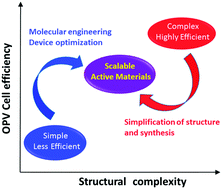
J. Mater. Chem. C, 2016,4, 3677-3685
https://doi.org/10.1039/C5TC03740A
Synthesis, properties, and OLED characteristics of 2,2′-bipyridine-based electron-transport materials: the synergistic effect of molecular shape anisotropy and a weak hydrogen-bonding network on molecular orientation
We investigated the synergistic effect of molecular shape anisotropy and intermolecular hydrogen-bonds in the BPy derivatives on molecular orientation towards OLEDs.

J. Mater. Chem. C, 2016,4, 3699-3704
https://doi.org/10.1039/C5TC03737A
Integration of aggregation-induced emission and delayed fluorescence into electronic donor–acceptor conjugates
Aggregation-induced emission and delayed fluorescence are observed simultaneously for the luminogens with an electron-donor and acceptor framework.
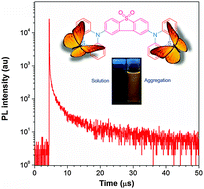
J. Mater. Chem. C, 2016,4, 3705-3708
https://doi.org/10.1039/C5TC03588K
N-Annulated perylene as a donor in cyclopentadithiophene based sensitizers: the effect of the linking mode
N-Annulated perylene (NP) functionalized cyclopentadithiophene dyes with different linking modes were synthesized and the peri-NP linked dye CPD-1 gave power conversion efficiency of 7.82% in Co(II)/(III) based dye-sensitized solar cells.

J. Mater. Chem. C, 2016,4, 3709-3714
https://doi.org/10.1039/C5TC03623B
A single emitting layer white OLED based on exciplex interface emission
A new triaryl molecule based on a benzene–benzothiadiazole–benzene core has been applied in a WOLED device.

J. Mater. Chem. C, 2016,4, 3851-3856
https://doi.org/10.1039/C6TC00750C
Solubilised bright blue-emitting iridium complexes for solution processed OLEDs
Combining a sterically bulky, electron-deficient cyclometalating C∧N ligands with an electron rich, highly rigidified N∧N ligand gives an iridium complex, that achieves extraordinarily bright blue emission (ΦPL = 90%; λmax = 459 nm in MeCN) for a cationic iridium complex.

J. Mater. Chem. C, 2016,4, 3726-3737
https://doi.org/10.1039/C6TC00151C
Shine bright or live long: substituent effects in [Cu(N^N)(P^P)]+-based light-emitting electrochemical cells where N^N is a 6-substituted 2,2′-bipyridine
Copper-based LECs with a maximum efficacy of 3.0 cd A−1 (luminance = 145 cd m−2) or with lifetimes >80 h have been achieved.
![Graphical abstract: Shine bright or live long: substituent effects in [Cu(N^N)(P^P)]+-based light-emitting electrochemical cells where N^N is a 6-substituted 2,2′-bipyridine](/is/Image/Get?imageInfo.ImageType=GA&imageInfo.ImageIdentifier.ManuscriptID=C5TC03725E&imageInfo.ImageIdentifier.Year=2016)
J. Mater. Chem. C, 2016,4, 3857-3871
https://doi.org/10.1039/C5TC03725E
High brightness solution-processed OLEDs employing linear, small molecule emitters
Two novel linear oligomers that can be solution-processed to form green organic light-emitting diodes (OLEDs) are reported.

J. Mater. Chem. C, 2016,4, 3774-3780
https://doi.org/10.1039/C5TC03579A
Solution-processed bulk heterojunction solar cells based on porphyrin small molecules with very low energy losses comparable to perovskite solar cells and high quantum efficiencies
The BHJ OSCs presented in this work show an energy loss of 0.53 eV but a maximum external quantum efficiency up to 61%.
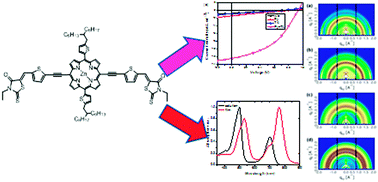
J. Mater. Chem. C, 2016,4, 3843-3850
https://doi.org/10.1039/C5TC04011F
Benzobisoxazole cruciforms: a tunable, cross-conjugated platform for the generation of deep blue OLED materials
A structure–property investigation of a series of cross-conjugated molecules shows that their performance is dependent on both the nature of the substituents and their conjugation axis.

J. Mater. Chem. C, 2016,4, 3765-3773
https://doi.org/10.1039/C5TC03622D
Effective modulation of an aryl acetylenic molecular system based on dithienyldiketopyrrolopyrrole for organic solar cells
Incorporating the 1,4-phenylene moiety leads to improving the photovoltaic performance.

J. Mater. Chem. C, 2016,4, 3757-3764
https://doi.org/10.1039/C5TC03844H
Highly efficient emitters of ultra-deep-blue light made from chrysene chromophores
The chrysene group, with its large band gap and high stability, was selected as a central core structure for ultra-deep-blue emitters. The effects of different side groups on the intrinsic properties of the chrysene core were systematically investigated.

J. Mater. Chem. C, 2016,4, 3833-3842
https://doi.org/10.1039/C5TC03749B
Engineering the singlet–triplet energy splitting in a TADF molecule
Environment plays a key role in the fine tuning of the energy levels of the charge transfer state with respect to the local donor or acceptor triplet state, which can be used to control the ΔEST in TADF molecules.
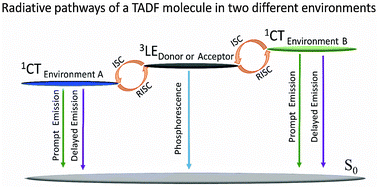
J. Mater. Chem. C, 2016,4, 3815-3824
https://doi.org/10.1039/C5TC03849A
Solution-processable thiadiazoloquinoxaline-based donor–acceptor small molecules for thin-film transistors
The thin-film transistors for compounds 1–3 show typical p-type performance with mobilities of 0.012, 0.05 and 0.0055 cm2 V−1 s−1 and on/off current ratios of 3 × 105, 1 × 106 and 1 × 104, respectively.

J. Mater. Chem. C, 2016,4, 3809-3814
https://doi.org/10.1039/C5TC03222A
Mapping the configuration dependence of electronic coupling in organic semiconductors
The varied topography of intermolecular electronic coupling offers a wide-ranging materials design landscape to engineer solid-state molecular packing for new generations of organic semiconductors.

J. Mater. Chem. C, 2016,4, 3825-3832
https://doi.org/10.1039/C5TC03765D
Development of strongly absorbing S,N-heterohexacene-based donor materials for efficient vacuum-processed organic solar cells
A new class of A–D–A molecular donor materials based on planar S,N-heterohexacenes is developed for vacuum-processed planar and bulk-heterojunction solar cells providing promising power conversion efficiencies up to 7.1%.

J. Mater. Chem. C, 2016,4, 3715-3725
https://doi.org/10.1039/C5TC03539B
Monodisperse macromolecules based on benzodithiophene and diketopyrrolopyrrole with strong NIR absorption and high mobility
A series of monodisperse macromolecules based on benzodithiophene and diketopyrrolopyrrole were designed, theoretically calculated, synthesized and compared, and they exhibited strong NIR absorption and high mobility.

J. Mater. Chem. C, 2016,4, 3781-3791
https://doi.org/10.1039/C5TC03589A
Synthesis and optoelectronic properties of chemically modified bi-fluorenylidenes
Unprecedented π-linkers suitable for dye sensitized solar cells.
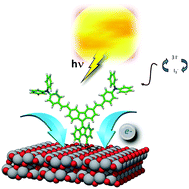
J. Mater. Chem. C, 2016,4, 3798-3808
https://doi.org/10.1039/C5TC03501E
Do charges delocalize over multiple molecules in fullerene derivatives?
We address the question of charge delocalization in amorphous and crystalline fullerene solids by performing state of the art calculations encompassing force-field molecular dynamics, microelectrostatic and quantum-chemical methods.
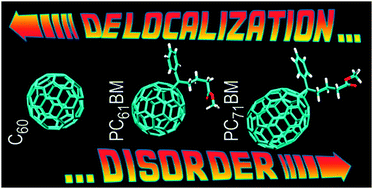
J. Mater. Chem. C, 2016,4, 3747-3756
https://doi.org/10.1039/C5TC03283K
Molecular design of host materials for high power efficiency in blue phosphorescent organic light-emitting diodes doped with an imidazole ligand based triplet emitter
Molecular design strategy to improve the power efficiency of blue phosphorescent organic light-emitting diodes was proposed by introducing a CN modified carbazole moiety.

J. Mater. Chem. C, 2016,4, 3792-3797
https://doi.org/10.1039/C5TC02595H
Tuning the oxidation potential of 2-phenylpyridine-based iridium complexes to improve the performance of bluish and white OLEDs
Electron-donating substituents are used to fine-tune the redox properties of sky-blue cyclometalated iridium complexes and improve their electroluminescence performance.

J. Mater. Chem. C, 2016,4, 3738-3746
https://doi.org/10.1039/C5TC02355F
Correction: Shine bright or live long: substituent effects in [Cu(N^N)(P^P)]+-based light-emitting electrochemical cells where N^N is a 6-substituted 2,2′-bipyridine
J. Mater. Chem. C, 2016,4, 3872-3872
https://doi.org/10.1039/C6TC90030E
About this collection
Advances in the chemistry, physics, engineering and technological applications of organic electronic materials are at the forefront of many global academic and industrial research programmes, with major economic, social and technological impact. Current topics of intense interest include organic photovoltaics (OPVs), organic LEDs (OLEDs), organic transistors, biological sensors, and energy and charge transport.
This thematic issue aims to highlight recent advances in organic electronic materials based on small molecules and monodisperse oligomers, including their synthesis, properties, applications or production. These advances can be experimental or theoretical studies in a materials context.